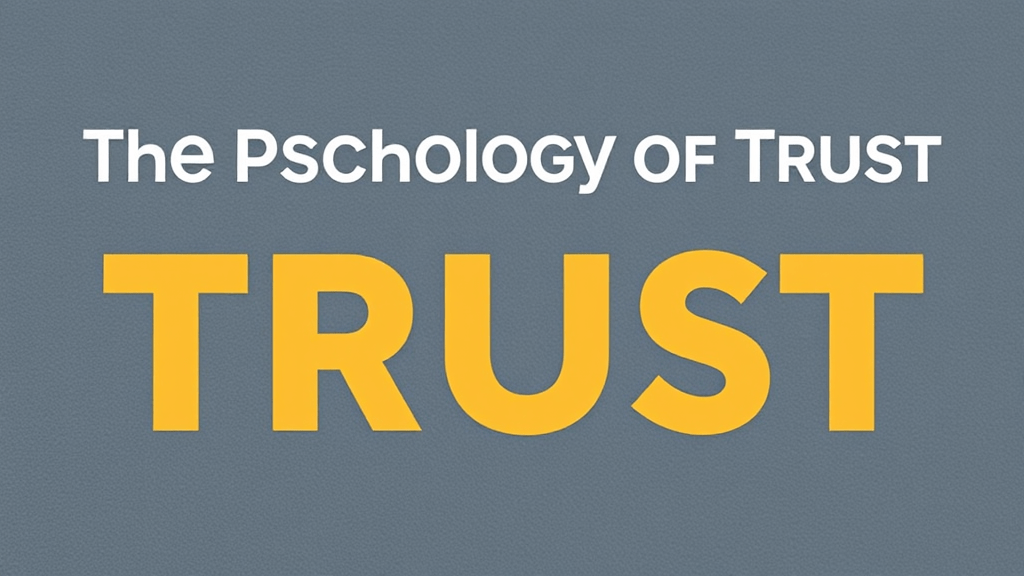Digital marketing has become an indispensable cornerstone for organizations seeking to reach, engage, and convert modern audiences. The abundance of online channels, coupled with increasingly savvy consumers, compels businesses to refine their strategies if they aim to stand out in a rapidly changing environment. Search Engine Marketing (SEM), in particular, has emerged as a critical differentiator in this space, guiding prospective customers to products and services with precision and efficiency. The future of Search Engine Marketing is tightly interwoven with broader digital marketing trends, as factors such as artificial intelligence (AI), voice and visual search, and changing consumer behaviors continue to shape how marketers approach online visibility.
The Ten Emerging Trends for the Future of Search Engine Marketing in 2025
Search Engine Marketing has always been at the forefront of digital marketing, enabling businesses to enhance their online visibility and drive meaningful conversions. As technology advances and consumer behavior evolves, the SEM landscape is experiencing rapid transformation. Companies that adapt to these changes will maintain a competitive edge in an increasingly crowded digital marketplace. Below are ten emerging trends shaping the future of SEM in 2025, along with actionable insights for businesses to refine their strategies and achieve sustainable growth.
1. The Rise of AI and Machine Learning in SEM
AI and Machine Learning (ML) are automating complex processes, refining targeting, and enabling real-time optimization. Platforms like Google Ads’ Smart Bidding are setting new benchmarks for efficiency and effectiveness [1]. By analyzing large datasets instantly, these systems can adjust bids to match the highest probability of conversion, reducing human guesswork.
What You Can Do:
- Adopt AI Tools: Utilize platforms such as Smart Bidding to optimize ad placements and budgets automatically.
- Use Predictive Analytics: Leverage AI to forecast campaign performance, refining targeting and bidding strategies for maximum ROI.
- Integrate Audience Insights: Tap into AI-driven audience segmentation tools to deliver highly personalized ads.
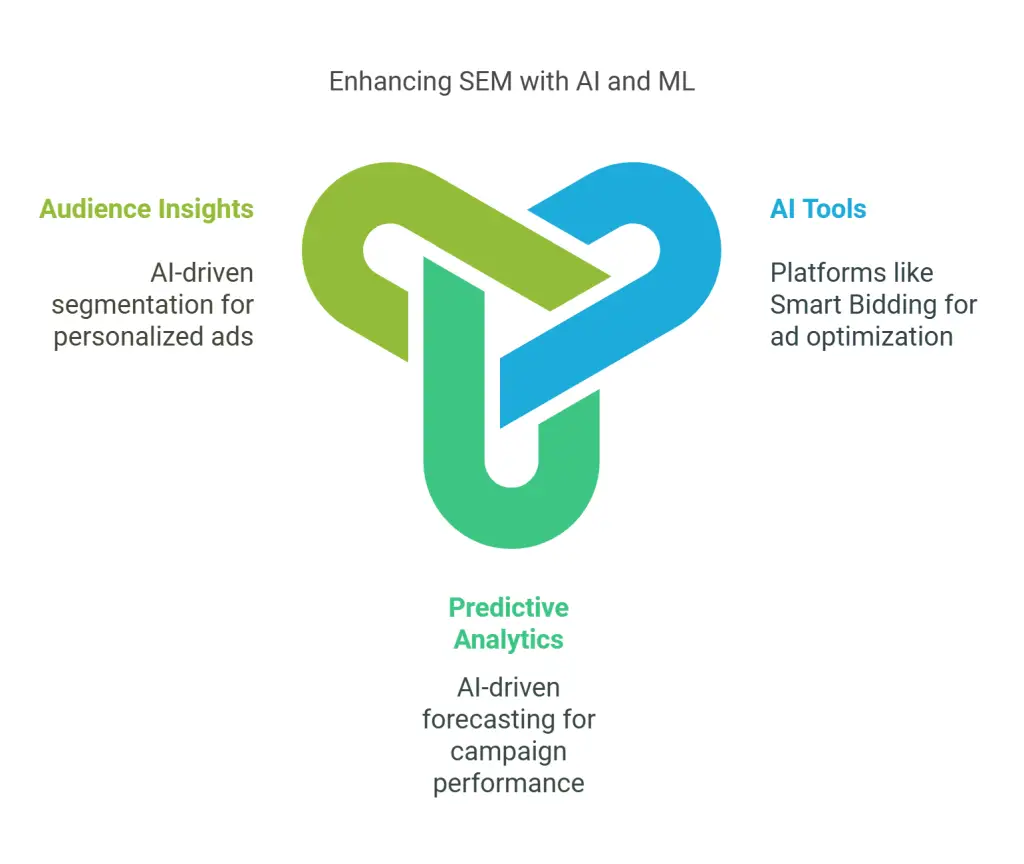
2. Voice Search Optimization
Voice search has grown exponentially with the widespread use of voice assistants like Alexa, Google Assistant, and Siri [2]. Unlike text searches, voice queries tend to be conversational and longer, prompting a shift in how businesses approach SEM. Voice users often look for immediate answers to location-based queries, opening new opportunities for businesses.
What You Can Do:
- Optimize for Long-Tail Keywords: Focus on keywords that reflect natural, conversational phrases such as questions.
- Emphasize Local SEO: Many voice searches target nearby services or businesses. Ensure local SEO strategy is robust by updating Google Business Profiles and using location-specific metadata.
- Create FAQ Sections: Cater to question-based voice queries with comprehensive FAQ pages, offering quick, concise answers.
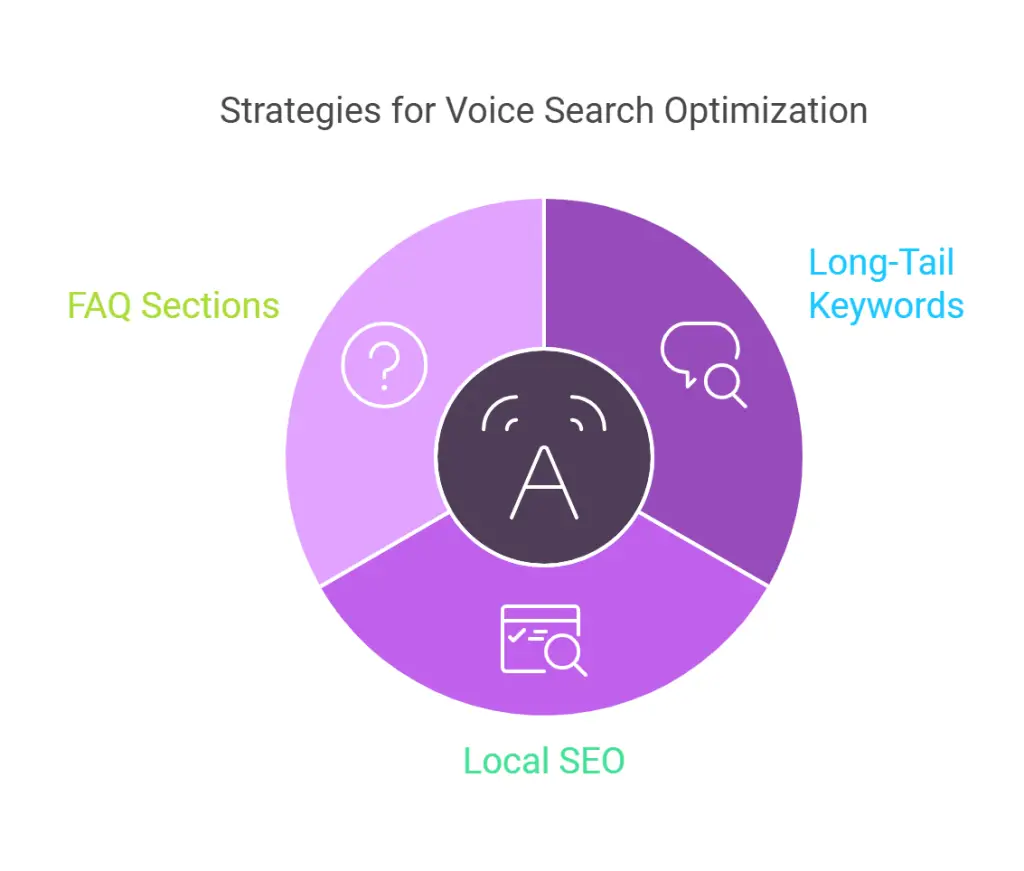
3. The Emergence of Visual Search
Visual search is transforming how users interact with search engines. Platforms like Google Lens and Pinterest lead this innovation, allowing users to search using images rather than text [3]. As consumers increasingly rely on images for product discovery, brands must ensure their visual assets are optimized.
What You Can Do:
- Optimize Visual Content: Use descriptive filenames and alt text to make images more accessible to search engines.
- Leverage Schema Markup: Implement structured data to help search engines understand visual assets.
- Align Visuals with Brand Identity: Consistent, high-quality imagery strengthens brand recognition and supports discoverability.
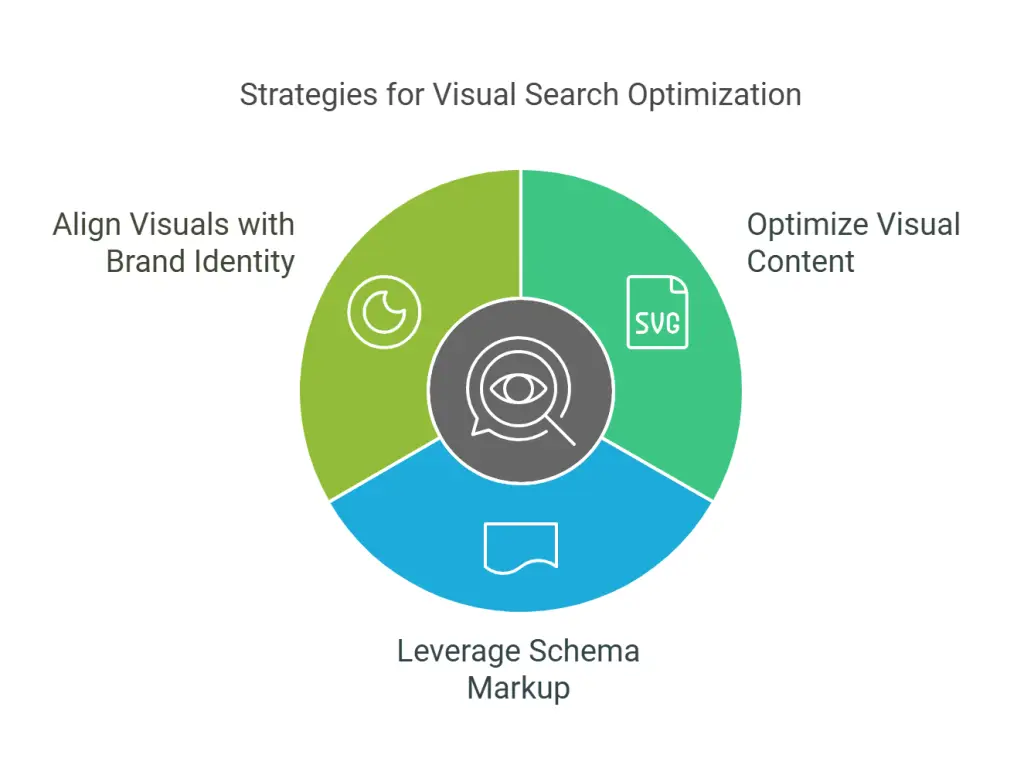
4. Zero-Click Searches Dominate
Zero-click searches, in which users find answers directly on the search results page, are increasingly prevalent. Featured snippets, knowledge panels, and AI-generated summaries minimize the need to click on individual links, changing the way marketers measure success [4]. As a result, businesses must adapt strategies to capture attention without relying solely on clicks.
What You Can Do:
- Target Featured Snippets: Optimize content to answer common questions succinctly, preferably within the first few lines of text.
- Enhance Metadata: Use concise, descriptive meta tags to improve visibility in zero-click results.
- Track Engagement Metrics: Consider new KPIs, such as brand mentions and impression share, since traditional clickthrough rates may decrease.
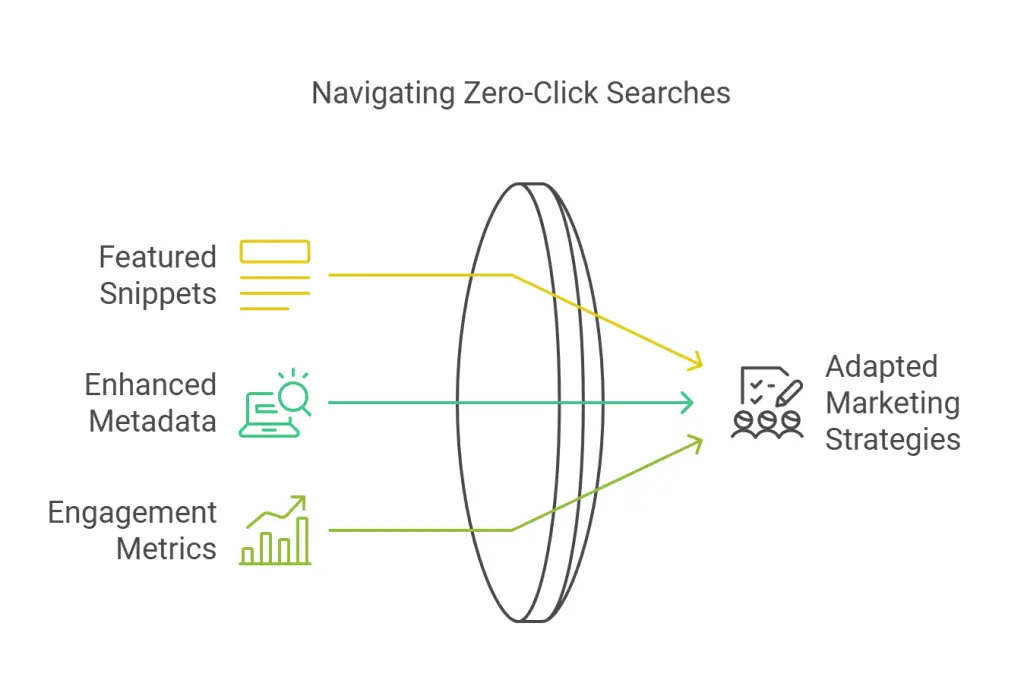
5. Search Generative Experience (SGE) and Conversational Search
Google’s AI-driven Search Generative Experience (SGE) is reshaping the future of SEM by offering personalized, conversational search results [5]. Users receive contextually relevant information in a dialogue-like format, which demands a shift toward user-focused, intent-driven content. Marketers must refine their campaigns to align with the complexities of conversation-based queries.
What You Can Do:
- Align Content with User Intent: Create content that directly addresses user queries in a clear, helpful manner.
- Stay Updated: Monitor algorithm changes and adapt strategy accordingly. Google frequently updates its systems to enhance SGE functionalities.
- Optimize Conversational Keywords: Consider synonyms, question forms, and colloquial language that mirror real-life dialogue.

6. The Rise of E-E-A-T Principles
Google now places a higher emphasis on Experience, Expertise, Authoritativeness, and Trustworthiness (E-E-A-T) when ranking content [6]. This evolution prioritizes authentic, credible, and high-quality content. It pushes SEM strategies to go beyond keyword stuffing, focusing instead on building a trusted presence in the eyes of users and search engines.
What You Can Do:
- Showcase Expertise: Highlight author credentials and maintain transparency in content, such as citing sources or including detailed bios.
- Build Authority: Acquire quality backlinks from trusted and authoritative websites.
- Foster Positive User Experience: Fast-loading pages, mobile-friendly layouts, and a clean website architecture all contribute to stronger E-E-A-T signals.
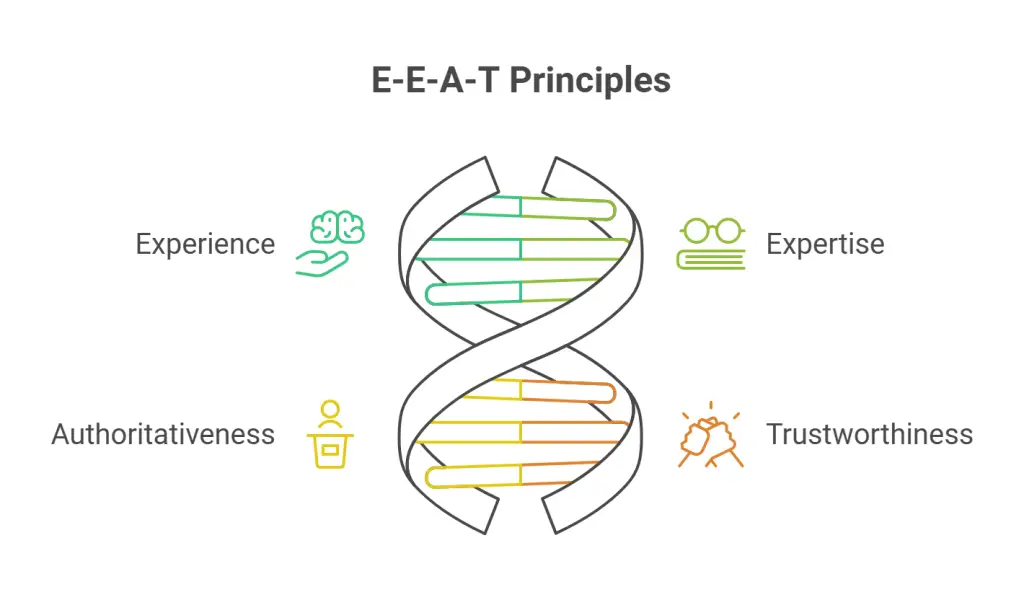
7. Short-form video Content for SEM
Short-form video platforms like TikTok, YouTube Shorts, and Instagram Reels have revolutionized content consumption, capturing user attention in brief yet impactful sequences [7]. These videos drive significant traffic to websites and products. For SEM, leveraging short-form video can amplify brand awareness and support remarketing campaigns.
What You Can Do:
- Create Engaging Videos: Develop short, visually appealing videos addressing audience pain points or showcasing products.
- Optimize Video Content: Use relevant descriptions, keywords, and hashtags for better discoverability.
- Integrate with Paid Search: Combine video assets with search ads to retarget users who have engaged with video content, guiding them further down the funnel.

8. Diversifying Search Platforms
Traditional search engines face competition from alternative platforms that younger audiences increasingly use for discovery, such as TikTok, Reddit, and Instagram [8]. Community-driven recommendations often carry greater authenticity, shifting how marketers allocate budgets and strategies.
What You Can Do:
- Expand Your Presence: Build a strong presence on alternative platforms like TikTok and Reddit, optimizing content for their unique search functionalities.
- Engage with Communities: Participate in discussions to establish credibility and visibility, as users often trust peer recommendations.
- Integrate Paid Campaigns: Complement organic efforts with paid promotion on these platforms, ensuring broader reach.
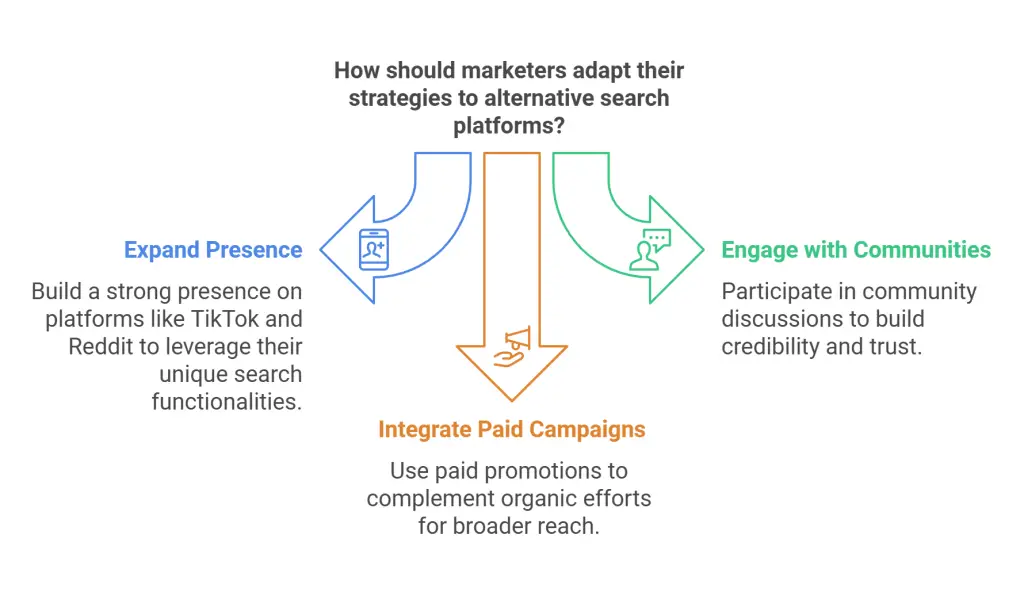
9. Balancing AI-Generated and Human Content
AI content generation tools offer fast, scalable content creation. However, authenticity and quality remain critical [9]. Over-reliance on AI-generated material risks creating a disconnect with audiences who crave human perspectives and emotional resonance. Businesses must strike a balance between efficiency and authenticity.
What You Can Do:
- Maintain Originality: Develop content reflecting your brand’s unique voice and values. AI can assist with outlines, but creative and strategic inputs benefit from human oversight.
- Implement Editorial Oversight: Ensure factual accuracy and relevance through thorough reviews, especially for data-sensitive or industry-specific topics.
- Use AI for Optimization: Employ AI for keyword research, content gaps, and on-page optimization, but rely on human expertise for final curation.
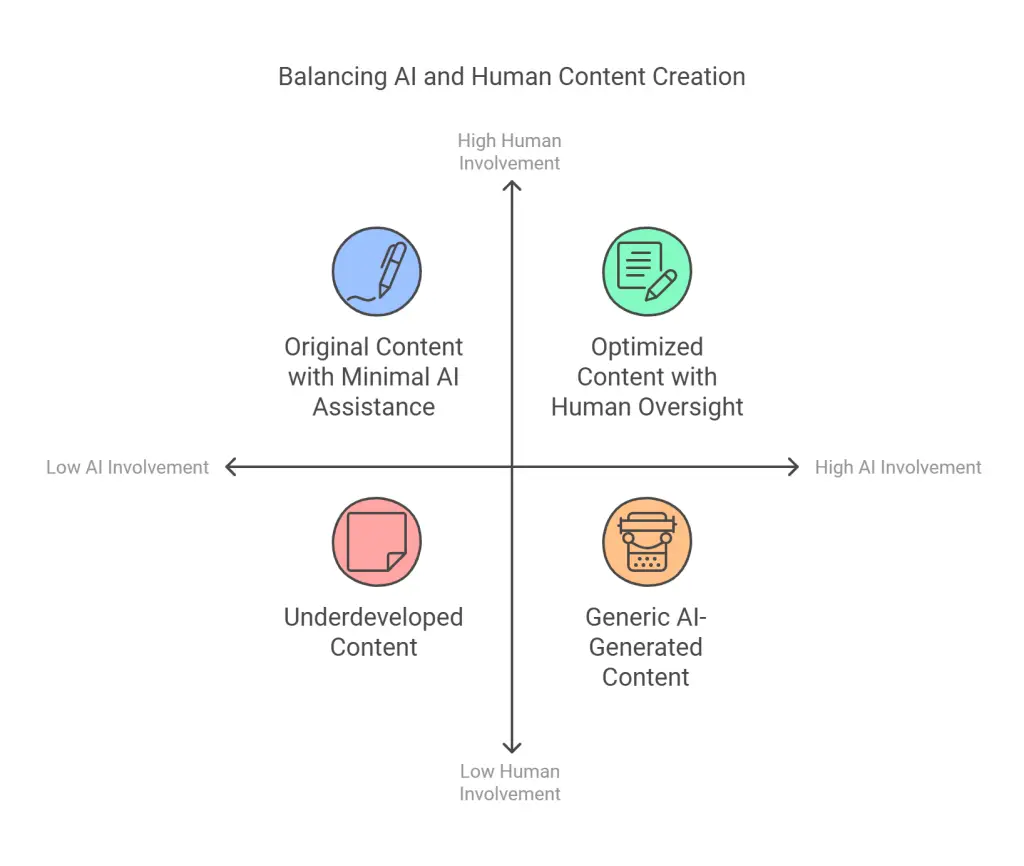
10. Ethical Marketing and Data Privacy
Stricter regulations around data privacy, including GDPR, CCPA, and upcoming global policies, mandate ethical marketing practices [10]. Businesses adhering to these guidelines often build stronger trust, securing a competitive advantage in user perception. Compliance in SEM involves transparent data handling, respectful retargeting, and credible reporting.
What You Can Do:
- Be Transparent: Communicate data collection practices in privacy policies, ensuring users understand what data you collect and how it is used.
- Adopt Privacy-Compliant Tools: Use analytics and tracking platforms aligned with data protection standards.
- Offer Value for Data: Make data-sharing a fair exchange by offering genuine value—such as personalized recommendations—to encourage consumer trust.
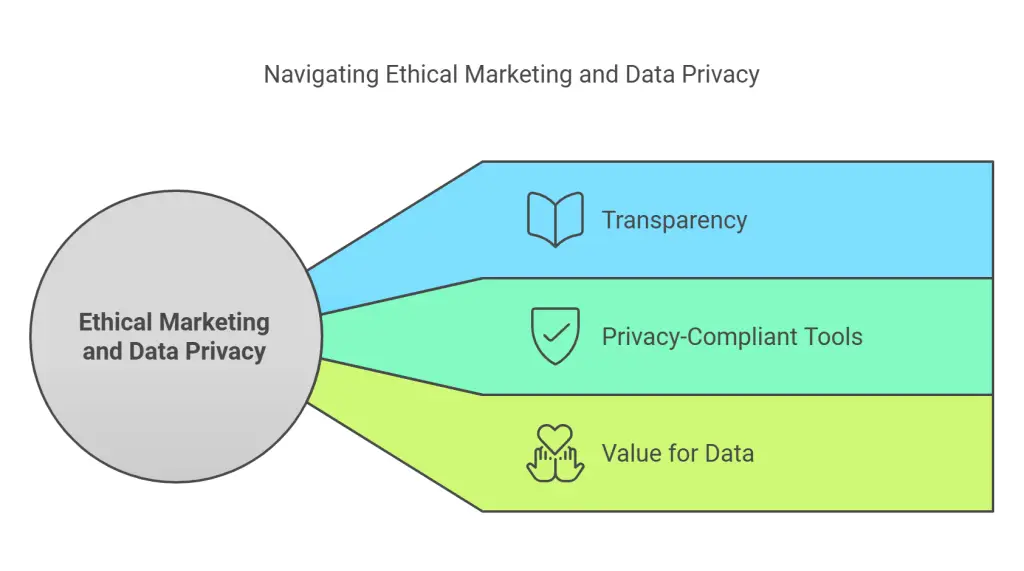
Case Study: How a Local Cafe Thrived in the New SEM Landscape
Business Overview:
Brews & Bites, a small coffee shop, found itself struggling to attract customers in a congested urban setting. Their online presence was minimal, making it difficult to stand out among competitors. They decided to overhaul their SEM strategy to gain traction both online and offline.

Challenges:
- Limited online visibility.
- Difficulty reaching local customers who might be searching for nearby cafes.
Solutions:
- AI-Driven Targeting: Brews & Bites adopted automated bidding strategies on Google Ads, adjusting bids to capture high-intent searches. They also used predictive analytics to forecast trends in coffee consumption, helping them optimize ad spend based on demand fluctuations.
- Voice Search Optimization: The cafe targeted voice-search keywords such as “best coffee shop near me” and “affordable pastries in town” by updating their website copy to mirror conversational phrasing.
- Visual Search Enhancements: High-quality images of latte art, pastries, and the interior were uploaded with descriptive filenames and alt text. Structured data provided search engines with details about menu items, price ranges, and operational hours.
Results:
- 30% Increase in Foot Traffic: Targeted ads and improved local SEO fueled an uptick in in-store visits.
- 20% Higher Conversion Rates: Personalized digital ads resonated with potential customers, driving more inquiries and orders.
- Enhanced Credibility: Brews & Bites featured prominently in local “Best Cafes” snippets on Google, boosting its reputation among area residents.
The Role of Digital Marketing Integration
Brews & Bites also experienced success by coordinating social media marketing, email campaigns, and content marketing with SEM. Instagram Reels showcasing latte art attracted a local following, while email newsletters distributed discount codes to repeat customers. This synergy created a cohesive brand experience that extended from social channels to search engines, reinforcing SEM efforts through consistent messaging.
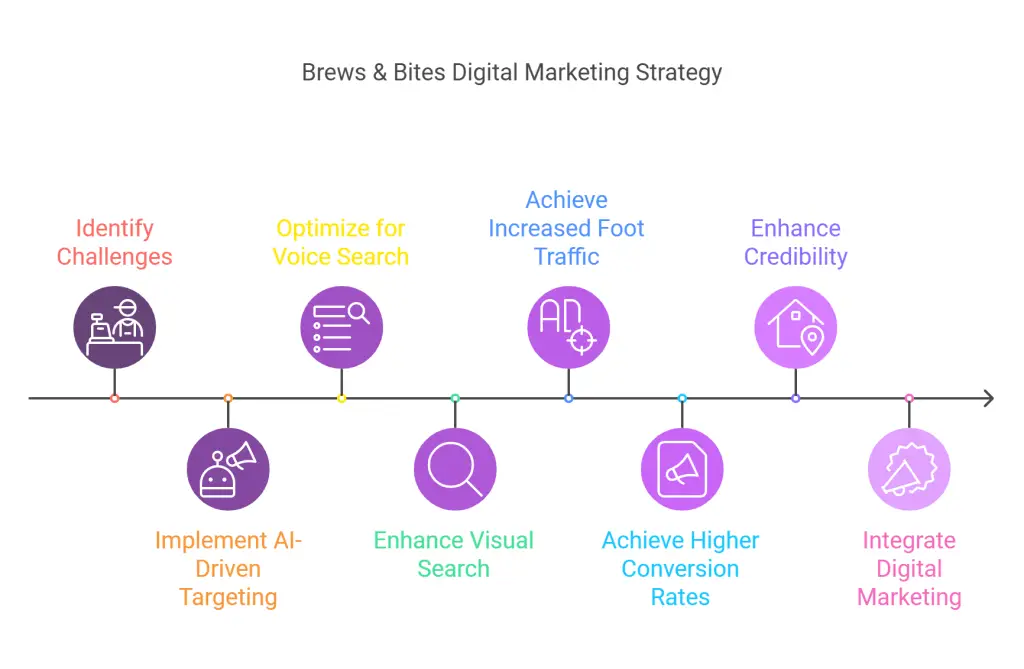
Potential Challenges in Adopting SEM Trends
- Steep Learning Curve: Advanced technologies like AI and ML require time and skill to implement effectively. Some businesses may lack the in-house expertise needed to fully leverage automated bidding or predictive analytics.
- Budget Constraints: Cutting-edge tools and campaigns can be costly. Small businesses may find it challenging to allocate sufficient funds toward these innovations without jeopardizing other marketing activities.
- Rapid Algorithm Changes: Search engine algorithms evolve frequently. Organizations must stay updated, continually testing and adapting their tactics. Neglecting these updates can hamper campaign performance.
Overcoming Challenges
- Start Small: Incrementally adopt new technologies like AI-based bid optimization. Test and refine campaigns before scaling to minimize financial risks.
- Explore Free Resources: Platforms such as Google Trends provide data on search popularity and can guide content creation and keyword selection without incurring extra costs.
- Collaborate with Specialists: Bringing in SEM experts or consultants can expedite the learning curve, ensuring that new tactics are deployed effectively.
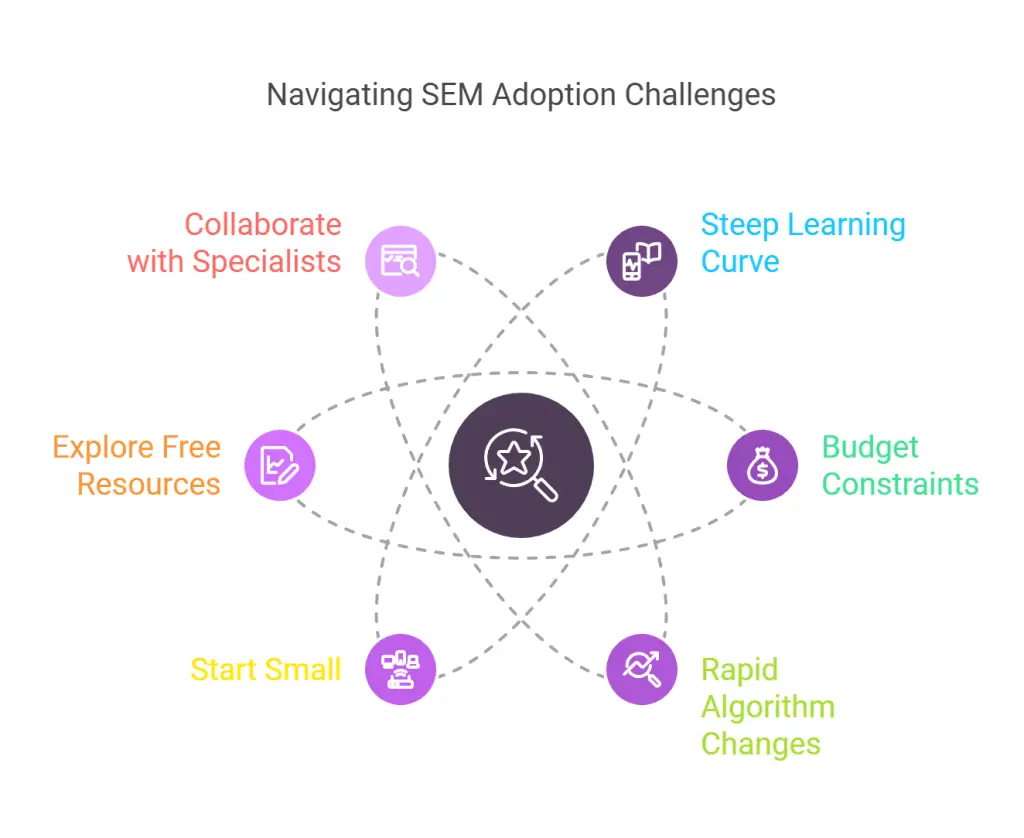
Extending SEM Beyond Search Engines
Many businesses mistakenly view SEM as synonymous with paid search on Google or Bing. However, the concept now extends beyond these platforms. Younger audiences turn to TikTok for reviews, unboxing videos, and tutorials, while communities on Reddit discuss product pros and cons in detail. Brands that proactively engage in these spaces can capture intent-driven queries before they even reach a traditional search engine. This shift demands a multi-platform approach where content is crafted and optimized for varying algorithms and user expectations.
For instance, short-form videos on TikTok can serve as a top-of-funnel strategy, capturing attention and redirecting viewers to relevant landing pages. Reddit posts, on the other hand, may target niche communities for in-depth discussions, effectively serving mid- to bottom-of-funnel stages where users seek comparative information. By expanding SEM efforts into these channels, businesses can build brand affinity and trust in addition to driving clicks and conversions.
Importance of Continuous Testing and Optimization
SEM success hinges on iterative testing. As AI-driven tools evolve, so do their predictive capabilities, but no algorithm is foolproof. Marketers must conduct A/B tests, measure performance across diverse audience segments, and refine approach accordingly. This entails monitoring metrics like cost per click (CPC), clickthrough rate (CTR), conversion rate (CVR), and return on ad spend (ROAS). When combined with robust analytics, these insights reveal whether campaigns align with business objectives.
Landing page optimization is similarly vital. Even the best-placed ads can underperform if the destination pages fail to convert. A focus on user experience, with clear calls-to-action (CTAs) and relevant content, ensures that traffic from AI-optimized ads results in measurable outcomes. Marketers should periodically reevaluate landing pages to align them with evolving user preferences and search engine guidelines.
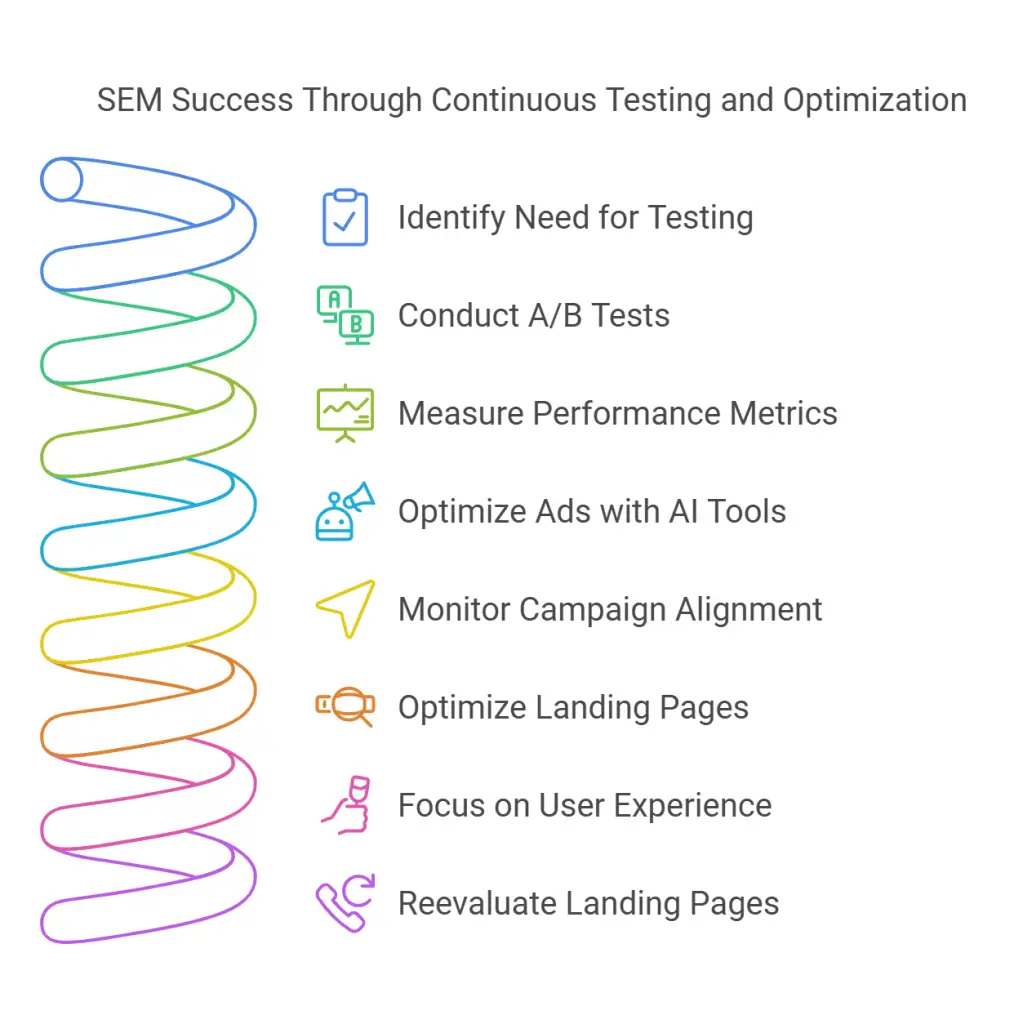
E-E-A-T as an Ongoing Effort
The Experience, Expertise, Authoritativeness, and Trustworthiness (E-E-A-T) framework is not a one-off optimization. It requires ongoing content audits, link-building initiatives, and user engagement strategies to maintain or improve search visibility. Businesses may choose to highlight real-world experience in their field through case studies, testimonials, or behind-the-scenes looks at manufacturing or service delivery. This practical demonstration reinforces the “Experience” component, while transparent sourcing and open communication of credentials strengthen perceived “Expertise” and “Trustworthiness.” High-quality backlinks from well-regarded publications further enhance “Authoritativeness,” creating a feedback loop where content credibility translates into search engine ranking gains, which in turn attract more attention and reliable backlinks.
Navigating Ethical and Privacy Challenges
As data-driven marketing becomes more sophisticated, the line between personalization and intrusion can blur. Ethical SEM practices revolve around obtaining user consent, safeguarding personal information, and using data responsibly. Companies that engage in transparent data handling often see a boost in public perception, which can translate to better clickthrough and conversion rates. GDPR and other regulations are not mere compliance hurdles; they function as frameworks ensuring businesses treat data fairly. Beyond regulatory obligations, this approach fosters brand loyalty, an asset that can outweigh any short-term gains from aggressive tracking.
The Future of SEM and the Expanding Role of AI
Looking ahead, the integration of AI in SEM will deepen, extending beyond bid management and segmentation into more nuanced territory like creative generation, real-time user personalization, and advanced predictive analytics. Semantic search, powered by AI, will become the norm, allowing search engines to better interpret user queries in context. As a result, marketers must focus on creating content that addresses user problems holistically, rather than relying on a simplistic keyword approach.
Industry leaders are already experimenting with deep learning models that analyze user behavior patterns across platforms. These models aim to predict not just the likelihood of a click, but also the probability of long-term engagement or brand loyalty. In this environment, data becomes the driving force, but it must be combined with human creativity for full effectiveness. AI can reveal what resonates, but human insight is essential to craft campaigns that move beyond surface-level engagement.
Building a Resilient SEM Strategy
A resilient SEM strategy is agile, data-informed, and user-centric. It capitalizes on emerging search trends without losing sight of foundational best practices, such as keyword research, ad copy testing, and landing page refinement. Because the digital environment is ever-changing, businesses that remain static risk losing relevance. Strategies should be revisited at regular intervals, incorporating feedback loops where performance data informs incremental improvements.
Collaboration across marketing disciplines is also key. SEM managers benefit from close communication with content, social media, and web development teams. Collective brainstorming can uncover new opportunities, whether it’s repurposing social media success into search campaigns or optimizing content for both SEO and paid search. This multi-faceted alignment fosters synergy that can magnify overall marketing outcomes.
Conclusion
SEM stands as a powerful lever in digital marketing, guiding potential customers through the most critical phases of the buyer journey. The future of search engine marketing in 2025 presents a wealth of opportunities driven by AI advancements, voice and visual search innovations, and evolving consumer behaviors. Businesses prepared to embrace new tactics—ranging from automated bidding and conversational search to short-form video ads—can maintain a competitive advantage in a crowded marketplace.
Achieving success in SEM hinges on integrating multiple strategies, including ethical data usage, adherence to E-E-A-T principles, and savvy adoption of alternative search platforms. Brews & Bites exemplifies how a small business can flourish by combining local SEO, AI optimization, and engaging visual content, boosting both online and in-store performance. While challenges such as budget constraints or steep learning curves may arise, systematic testing and collaboration with experts provide a viable path forward.
Adaptability, innovation, and a customer-first approach are crucial in this dynamic field. As search experiences become more intuitive, zero-click queries rise, and new platforms gain popularity, marketers have myriad channels to connect with their audiences. Those who remain agile—continuously refining strategies, integrating new technologies responsibly, and focusing on authentic engagement—are positioned to thrive in the coming era of SEM.
Frequently Asked Questions
How are AI and machine learning transforming SEM strategies?
AI and machine learning are automating complex processes in SEM, enhancing targeting precision and enabling real-time optimization. Tools like Google’s Smart Bidding analyze vast datasets to adjust bids dynamically, improving conversion probabilities and reducing manual interventions.
What impact does voice search have on SEM?
The rise of voice assistants has led to more conversational and longer search queries. To adapt, businesses are focusing on long-tail keywords and enhancing local SEO strategies, ensuring their content aligns with natural language patterns used in voice searches.
Why is optimizing for visual search important in 2025?
Visual search, enabled by platforms like Google Lens, allows users to search using images, changing how consumers discover products. Optimizing visual content with descriptive filenames and alt text ensures better accessibility and visibility in search results.
How does user experience (UX) influence SEM effectiveness?
A positive UX, characterized by fast load times and mobile-friendly designs, leads to higher engagement and conversion rates. Search engines prioritize websites that offer seamless experiences, making UX a critical factor in SEM success.
What role does data privacy play in shaping SEM strategies?
Increasing data privacy regulations are prompting businesses to adopt transparent data collection practices. Building trust through compliance not only safeguards user information but also enhances brand reputation, influencing SEM outcomes positively.
Further reading
Huble. “7 Search Engine Marketing Strategies for 2024.” Huble, March 5, 2024. https://huble.com/blog/search-engine-marketing-strategies. (Accessed March 7, 2025).
LuminateCX. “The Future of Search Engines and AI.” LuminateCX, February 29, 2024. https://www.luminatecx.com/blog/the-future-of-search-engines-and-ai. (Accessed March 7, 2025).
Ikius. “Is Search Engine Marketing Coming to an End?” Ikius, January 18, 2024. https://ikius.com/blog/search-engine-marketing-end. (Accessed March 7, 2025).
Single Grain. “5 Search Advertising Trends That Will Define 2024.” Single Grain, February 14, 2024. https://www.singlegrain.com/advertising/search-advertising-trends/. (Accessed March 7, 2025).
Northwestern University Medill IMC. “Search Engine Marketing Trends in 2024.” IMC Professional Blog, March 1, 2024. https://imcprofessional.medill.northwestern.edu/blog/search-engine-marketing-trends. (Accessed March 7, 2025).
Google Search Central. “How AI Is Changing Google Search.” YouTube, uploaded February 15, 2024. https://www.youtube.com/watch?v=HAjWMmFltyI. (Accessed March 7, 2025).





